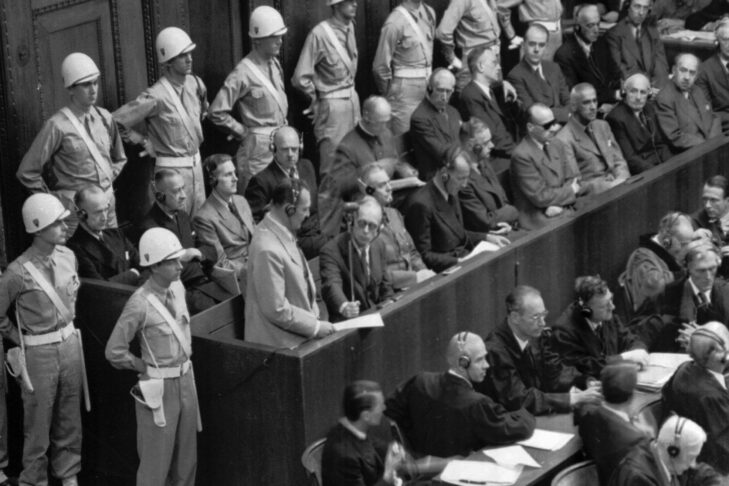Seventy-five years ago this month, on Sept. 17, 1945, the first trial to apply international law to crimes committed by Nazi functionaries opened in Lüneberg, Germany. Pushed to end before the mid-November start of the Nuremberg trials, which focused on “crimes against peace,” “crimes against humanity” and “war crimes,” Britain’s “Belsen trial,” convened under its Royal Warrant, sought solely to prosecute those who acted criminally in concentration camps, participating in a system calculated to murder millions. By admitting evidence of atrocities committed by Germans against German or axis nationals, it set a precedent for the series of trials to follow: no longer would “sovereign immunity” automatically shield war criminals. This position was not a given.
The British Second Army had liberated Bergen-Belsen on April 15. What they found in the then-largest concentration camp was indescribable. Still, the Belsen trial’s first witness, Brigadier H. L. Glyn Hughes, the military officer who had assumed responsibility for medical relief at Belsen, tried to give a picture. In Camp One, five compounds contained more than 41,000 emaciated inmates in severely overcrowded, filthy huts. Seventy percent of them required immediate hospitalization. Of these, Hughes estimated that 14,000 would die before they could receive treatment. Ten thousand unburied corpses lay in mounds on the ground, among the living in some huts and floating in concrete ponds of water. Epidemics of typhus, tuberculosis and gastroenteritis raged. Camp Two contained another 15,000 starving prisoners.
Accompanying the British Army into Bergen-Belsen was its film and photographic unit. Together with journalists, they captured evidence of Nazi barbarity. Though the Allied Control Council had yet to provide a uniform basis for prosecuting war criminals, outraged British citizens demanded justice. A trial slated to begin in July was delayed only because more time was needed to collect evidence. All summer, investigators, military officers and translators walked through the camp with stacks of photographs of guards and kapos, gathering affidavits from witnesses.
Most of the 45 S.S. and kapos charged with participating in the ill treatment and murder of inmates at Bergen-Belsen had served, earlier, in Auschwitz. While overseeing a compound of 18,000 women, Irma Grese (then 19) used her special whip. Juana Borman, at 52 the oldest of the female guards, delighted in watching her dogs tear prisoners to pieces. Josef Kramer, who supervised the gassing of thousands at Auschwitz, went on to become kommandant and “Beast of Belsen.” He casually shot 22 prisoners the day before the British arrived. These murderers sat among the other defendants in a dock in the gymnasium-turned-courtroom, in the outskirts of Lüneberg. Hundreds more had fled at the time of the liberation.
Just as the British were unprepared for what they found in Bergen-Belsen, they (and their allies) had no experience investigating and prosecuting such criminality. The act and effects of denying humans habitable quarters, medical and sanitary facilities and food and water defied comprehension. How to proceed? Was “the proper treatment of citizens of nations occupied by a belligerent” outlined in Britain’s Manual of Military Law a fair consideration? Deciding to adhere to judicial norms, the British court would strive for evenhandedness and moderation.
Observers called the approach blasphemous.
Colonel Smith, a London University professor of international law brought in to help the defense, argued that actions consonant with German law—which permitted the annexation of territory, the establishment of concentration camps, the confinement therein of prisoners and the construction and use of gas chambers—were lawful. As “war crimes” had only to do with actual warfare, national socialist racial policy, which subjected civilian prisoners to atrocities, fell outside the purview of the charges. The 11 defense lawyers concurred; the German’s duty was to obey his country’s law, even if it conflicted with international law.
Defense lawyers attacked survivor-witnesses who omitted in their testimonies incidents mentioned in earlier statements—or who mentioned incidents not in statements. They accused witnesses of combining trivial incidents to produce grave ones and of attributing remembered events to those in custody. They failed to understand the impossibility of knowing and keeping track of dates and times, and that questions might evoke recollections.
Helen Klein accused Franz Hoessler of selecting her for the gas chamber at Auschwitz, of telling her that at age 19 she had “lived long enough.” Another witness told how Hilda Lobauer beat and drowned women prisoners by pushing them into a ditch. Ada Bimko recounted, with tears, how members of her family, including her 6-year-old son, died at Auschwitz. She explained how the sonderkommando were forced to bring bodies from the gas chambers to the crematoria. She identified Karl Francioh, supervisor of the cookhouse at Belsen, as the man who shot an inmate the day before the British arrived. And she saw Kramer kicking and beating prisoners. A defense counsel suggested that she fabricated statements about Kramer’s brutality.
Survivor Anita Lasker-Wallfisch concluded that the trial was a “huge farce.” Others, too, thought the bending over backwards to allow the testimony and defense of the perpetrators an insult to those who had died, and to Belsen’s liberators. Criticizing protracted British justice and indulgence of the defendants, a Russian reporter called for the trial’s immediate end. A Moscow radio commentator said it encouraged fascists everywhere.
In his affidavit, Dr. Klein, one of the accused, said he told Kramer that had he been the English officer in charge, he would have taken them both, put them against the wall and shot them.
The Belsen trial defense attorneys would not have the final word. In his closing speech, prosecuting attorney Colonel T. M. Backhouse of Headquarters, British Army of the Rhine, refuted each of the points raised by Colonel Smith. He submitted that interned civilians, including inhabitants of countries occupied by Germany during the war, were entitled to the same treatment as prisoners of war (as outlined by the Geneva Convention of 1929), and that all forms of cruel treatment were prohibited. He detailed the murderous scheme to which Auschwitz internees were subjected, and the continuation of brutalization and mass murder, in a different form, in Bergen-Belsen. He reviewed the testimony incriminating each of the accused, and noted the problems of collecting evidence from those preoccupied, post-liberation, with trying to survive or save the dying. He remarked on the telling consistencies among various affidavits.
The Belsen trial’s verdict: 14 of the defendants were acquitted; 31 were found guilty. Of these, 11 were sentenced to death. The meticulous executioner Albert Pierrepoint hanged the eight men and three women on Dec. 13, 1945, in a jail in Hamelin.
Like the Belsen trial, the Nuremberg trials would reject summary executions and seek to create authoritative, historical records. Focusing on the Nazi regime’s conspiracy to aggression, the International Military Tribunal that produced Nuremberg—comprising the United States, Britain, France and Russia (each with its own prosecution agendas)—set standards for prosecuting crimes against humanity. It looked to an example, among hundreds of trials it overshadowed, the Belsen trial, the first to consider not only defendants’ individual war crimes, but also their part in a scheme to torture and murder Jews and other targeted victims, regardless of nationality.
This article was originally published in JNS.org and is reposted with permission.
This post has been contributed by a third party. The opinions, facts and any media content are presented solely by the author, and JewishBoston assumes no responsibility for them. Want to add your voice to the conversation? Publish your own post here. MORE



